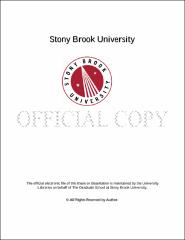| dc.identifier.uri | http://hdl.handle.net/11401/77659 | |
| dc.description.sponsorship | This work is sponsored by the Stony Brook University Graduate School in compliance with the requirements for completion of degree. | en_US |
| dc.format | Monograph | |
| dc.format.medium | Electronic Resource | en_US |
| dc.language.iso | en_US | |
| dc.publisher | The Graduate School, Stony Brook University: Stony Brook, NY. | |
| dc.type | Dissertation | |
| dcterms.abstract | Understanding Earth's internal structure by seismic observations, both temporally and spatially, is key in seismology. In this thesis, I constrained structural changes beneath the Japan subduction zone based on a newly developed theory, and detailed mid to lower mantle structure beneath Central America by waveform and travel time observations and modeling. A newly developed theory states that the differential wave field of two repeated sources in a temporally changed medium can be equivalently treated as wave fields propagating from virtual point sources or volumetric sources. The virtual point sources or volumetric sources are located at the place of temporal changes, and their strengths are equal to the product of magnitude of medium property change and magnitude of the initial wave fields from the repeated sources. Applying the theory to the Japan subduction zone, we then locate the temporal change of seismic properties beneath this area between 2011 and 2013 to be at (37.2°N,142°E), and estimate the magnitude of the conceptual body force associated with the temporal change to be 1.15×10^10 N, or as a reference, a 0.87% density change for an assumed volume of temporal change of 10^3 km3. Seismic waveform and travel time observations sampling the mid to lower mantle beneath Central America are analyzed and modeled. Waveform observations show complex reflection phases and exhibit significant variations with azimuth and distance, and travel time analyses show increasing S residuals of up to 9 seconds as distance increases from 45° to 80°. Forward waveform and travel time modeling reveals that several sub-horizontal 10-20 km thick segments with -10% shear wave velocity perturbation are buried inside a " trapezoid-like" low velocity region with -2% shear wave velocity perturbation extending between 1000 and 2750 km depth. In addition, analyses of the ScSH-SH and PcP-P differential travel time residuals suggest a structural transition in the lowermost mantle beneath Central America. Comparisons of stacked waveforms across the region indicate relatively uniform attenuation. Rapidly changing ScSH/SH amplitude ratio and incoherently delayed radial component S phases both indicate widely existing anisotropy and heterogeneity. | |
| dcterms.abstract | Understanding Earth's internal structure by seismic observations, both temporally and spatially, is key in seismology. In this thesis, I constrained structural changes beneath the Japan subduction zone based on a newly developed theory, and detailed mid to lower mantle structure beneath Central America by waveform and travel time observations and modeling. A newly developed theory states that the differential wave field of two repeated sources in a temporally changed medium can be equivalently treated as wave fields propagating from virtual point sources or volumetric sources. The virtual point sources or volumetric sources are located at the place of temporal changes, and their strengths are equal to the product of magnitude of medium property change and magnitude of the initial wave fields from the repeated sources. Applying the theory to the Japan subduction zone, we then locate the temporal change of seismic properties beneath this area between 2011 and 2013 to be at (37.2°N,142°E), and estimate the magnitude of the conceptual body force associated with the temporal change to be 1.15×10^10 N, or as a reference, a 0.87% density change for an assumed volume of temporal change of 10^3 km3. Seismic waveform and travel time observations sampling the mid to lower mantle beneath Central America are analyzed and modeled. Waveform observations show complex reflection phases and exhibit significant variations with azimuth and distance, and travel time analyses show increasing S residuals of up to 9 seconds as distance increases from 45° to 80°. Forward waveform and travel time modeling reveals that several sub-horizontal 10-20 km thick segments with -10% shear wave velocity perturbation are buried inside a " trapezoid-like" low velocity region with -2% shear wave velocity perturbation extending between 1000 and 2750 km depth. In addition, analyses of the ScSH-SH and PcP-P differential travel time residuals suggest a structural transition in the lowermost mantle beneath Central America. Comparisons of stacked waveforms across the region indicate relatively uniform attenuation. Rapidly changing ScSH/SH amplitude ratio and incoherently delayed radial component S phases both indicate widely existing anisotropy and heterogeneity. | |
| dcterms.available | 2017-09-20T16:53:14Z | |
| dcterms.contributor | Wen, Lianxing | en_US |
| dcterms.contributor | Holt, William | en_US |
| dcterms.contributor | Weidner, Donald | en_US |
| dcterms.contributor | Li, Baosheng | en_US |
| dcterms.contributor | Zhu, Lupei. | en_US |
| dcterms.creator | Long, Hui | |
| dcterms.dateAccepted | 2017-09-20T16:53:14Z | |
| dcterms.dateSubmitted | 2017-09-20T16:53:14Z | |
| dcterms.description | Department of Geosciences. | en_US |
| dcterms.extent | 126 pg. | en_US |
| dcterms.format | Application/PDF | en_US |
| dcterms.format | Monograph | |
| dcterms.identifier | http://hdl.handle.net/11401/77659 | |
| dcterms.issued | 2014-12-01 | |
| dcterms.language | en_US | |
| dcterms.provenance | Made available in DSpace on 2017-09-20T16:53:14Z (GMT). No. of bitstreams: 1
Long_grad.sunysb_0771E_12104.pdf: 50131032 bytes, checksum: 967b4f49547facd075ae6c3ed33acfb4 (MD5)
Previous issue date: 1 | en |
| dcterms.publisher | The Graduate School, Stony Brook University: Stony Brook, NY. | |
| dcterms.subject | Central America, Japan, Modeling, Seismic observation, Seismic structure, Seismology | |
| dcterms.subject | Geophysics | |
| dcterms.title | Using Seismic Observations and Modeling to Place Constraint on the Structure Beneath Japan and Central America | |
| dcterms.type | Dissertation | |

